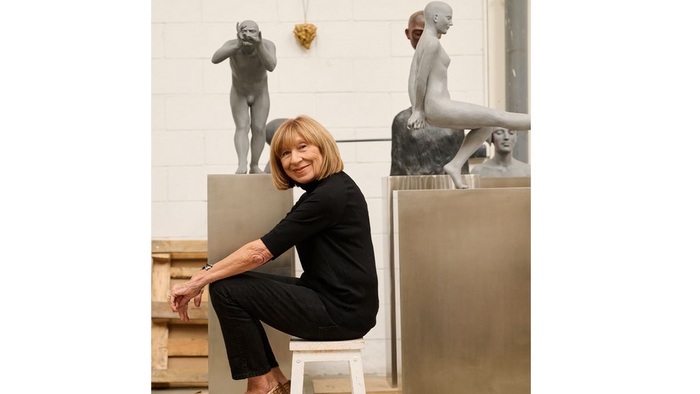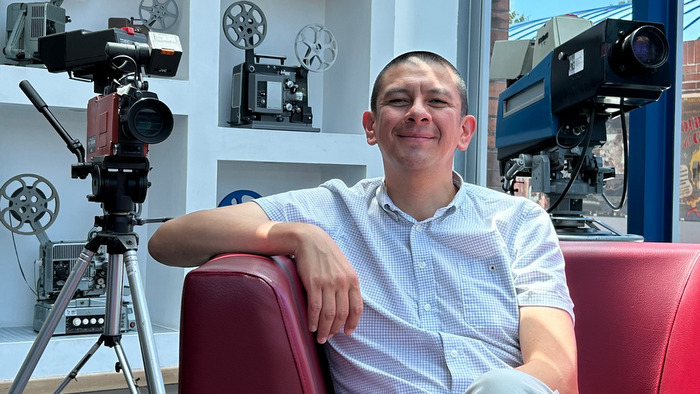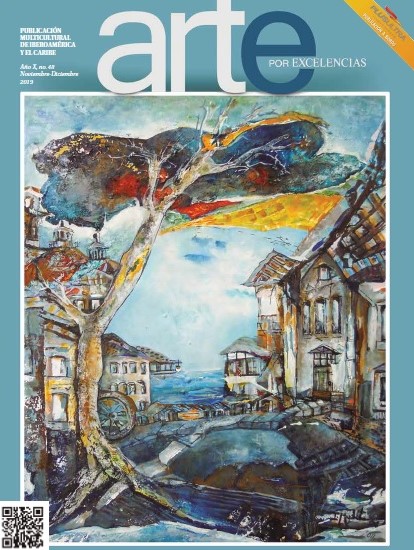By Ricardo Potts
Who is Maria Porto, how did she begin in art and collecting?
I’m a movie screenwriter’s daughter, something that is normal today but not during my childhood. I grew up in a different world at that time and I had an atypical formation in the sense that with five years my father was writing films, filming The dog with Pilar Miró, he made several major films and received El Oso de Plata (the Silver Bear) in Berlin. He insisted that his children get involved in "serious" degree courses because, though he triumphed in the profession, he lived tough early years. Then I studied Law, but being a sophomore, when my friends were going to the High Court to see judgments, I went to see the Guernica.
One day I was called from the Marlborough Gallery, which had not yet premises in Spain, for me to help them during the ARCO Fair, and from that time on I worked with them in all the event’s editions. When Marlborough decided to open a gallery in Madrid, I had just finished college. The International President, Pierre Levai, was very happy with my work and offered me to work with him but from the bottom level: I would begin working as receptionist in Marlborough.
After 15 days working there I already knew I wanted to be a curator. Pierre told me: "You will be the next director of my gallery." I was 22 and I thought he was a very polite gentleman but, indeed, when I was 26 years I was the director of the entire management section. Marlborough was a gallery as American companies are: I was at the reception, in the graphic section, I learned to hang, to illuminate and I mounted exhibitions. The first one was in 1994, with Botero in the street, and now when I think about it I say, "My God, how was it possible!”
 At age 30 I was the youngest director in the history of Marlborough, I met many famous artists and at 32 I felt I had peaked professionally. I was delighted with my career in Marlborough, but I could not stay stagnant and I had many concerns. So I started on my own and mounted Aqualium, a company dedicated primarily to public art; I began to do more exhibitions and to advise as private dealer. One day El Corte Inglés crossed my path and, speaking of its tradition of doing artistic showcases, emerged the idea of ??bringing the art class to the general public. For twenty years I have been a gallery owner and we have done something wrong because there is a large audience that is approaching us, that is sensitive, that wants to buy its first work and does not dare to enter a gallery. Now El Corte Inglés gives them the chance, in an absolutely careful environment, of approaching the great artists without fears and without anyone "spares their life."
At age 30 I was the youngest director in the history of Marlborough, I met many famous artists and at 32 I felt I had peaked professionally. I was delighted with my career in Marlborough, but I could not stay stagnant and I had many concerns. So I started on my own and mounted Aqualium, a company dedicated primarily to public art; I began to do more exhibitions and to advise as private dealer. One day El Corte Inglés crossed my path and, speaking of its tradition of doing artistic showcases, emerged the idea of ??bringing the art class to the general public. For twenty years I have been a gallery owner and we have done something wrong because there is a large audience that is approaching us, that is sensitive, that wants to buy its first work and does not dare to enter a gallery. Now El Corte Inglés gives them the chance, in an absolutely careful environment, of approaching the great artists without fears and without anyone "spares their life."
So, those are the main objectives of this space?
Precisely, and we still have a very tiny path because a year in the art’s world is nothing. We are starting to walk together and I have given all the facilities to carry out the project. In the first exhibition we put a sculpture of Gerardo Rueda, going back to 1963, when the first artistic showcases were done. At first I was a little afraid to approach the artists with this idea, but after almost 22 years of experience they are all friends of mine and you’ll be surprised with the wonderful reaction that many of them had to these projects. Miguel Navarro, Gerardo Rueda... all major artists supported us. I think here we have broken barriers, with a wonderful team of graduates in Fine Arts and a very special sensitivity. Nobody has to be ashamed not to distinguish an engraving from a lithography; we are here to explain it.
For example: we are selling engravings of Luis Gordillo, National Award 2011, to people who had never bought a work of art. Artists can see beyond what most of the people are able to see and that opens many ways. I hope we’ll be able to transmit to people what we have been given, when they see a great work of art, even in a small part. We do not intend to teach or educate, that would be pretentious; we just want to share experiences with the public.
Why "The Garage"? Why artists of different generations and styles? Is this the first time you make an exhibition of engravings?
The exhibitions are collective because we also want to show unknown artists and have this to be a showcase of everything that is happening. We do not want to be identified only with the more acclaimed artists; we look for young artists to have here also a platform to exhibit. Why a Garage? Because in New York and London there are being used industrial buildings, garages and other facilities to expose, hence the idea of ??a more accessible place here, and so we are breaking the last barriers, because everyone enters in a garage and there is absolutely everything. We have even included a Harley motorcycle to make it easier for the younger audience which, though they will not buy now, they will someday because they will “carry it” in the retina.
Speaking of the Harley and signals in this project, including the music, is like an old-fashioned New York...
Sure, it’s a New York with an atmosphere of the 50s-60s. We have allowed ourselves to play around with the scenery and time, as we are also making an artistic journey from Miro, Antoni Tapies, Saura, to younger artists, and others such as Larry Rivers, representative of the American Pop Art, whom I had the privilege of knowing because I had an exhibition of his at Spain while I was working in Marlborough. In the end I realize that people has sensitivity for beautiful things, the music of the fifties, for example, or for a Harley, that for many it is an object of worship for many.
There are people who come for a weekend with their children, parents alike come to see the Tàpies, and children, when they're watching the Harley, they have Saura behind, and at the end the eye is educated seeing, there’s no other way. Finally, when you start to see historical art, you begin to see the absolute references, because they all go drinking from the previous sources.
Mention five artists who you would save in the Ark of the Flood.
I won’t mention an artist alive. In artists of any era, I would take a Velázquez, a Goya, the bison of Altamira where there are a lot of current references, a Matisse for the essence of the absolute summary and nearer I would take a Freud because it is the tearing and suffering of the artist led to the canvas. I would save five others, but let's stay here for anyone not to be angry. Today’s painting is not understood without Goya and without Velázquez.
How do you manage to coordinate so many things with your personal life?
Like most women of the XXI century, getting up at 7 in the morning, going to bed at 12 or one in the morning, and always going down bad with someone. The project continues to grow, we begin with this space here at El Corte Inglés of Castellana, we have another small space at Diagonal in Barcelona, ??and last week we opened in Puerto Banús. But I have a privilege, because my work is my passion, and to get up every morning is not going to work, but to enjoy. I'm not saying that I’m not late at home, that children occasionally don’t hide me their duties... in the end, just like all women. But is such the personal satisfaction and what I do is so fulfilling that I could not live otherwise.
Yet in the world of art, in the commerce and the commission, we are far more women, I don’t know if it is because we can be in several places at once. It is true we have sensitivity to deal with artists, who are special people, who are every day studied. When I get up in the morning I know more or less what I have to do. Instead, an artist goes daily to his studio to face a canvas or a blank paper. That causes in me an enormous respect. In addition, every time they make an exhibition they still face criticism, they continue undressing with that four or five years’ work, even well-known artists. I think is such a suffering, dedicated job, that I find it admirable.
Let’s say you cannot make a clear limit between personal life and work.
I do not make it, because on Sunday I take my kids to see Les Menines for the eighteenth time. It’s true I was lucky, and I always say it, to have a wonderful father, the movie gatherings dome at home, that with five years my father told me about the persistence of vision and the 24 frames per second... he arouse in us the curiosity about everything. I’ve been taught to live in a way, and not only in my profession, because I care about the cuisine, art, journalism, travels... I would need three lives to see everything I’m interested on. What I do understand now that I have 43 years is that life is too fast and the longer I live the more I see what I still lack and what I'm not going to have, even if I live 24 hours a day.
No doubt, as the philosopher said, "the more knowledge, the more doubt." Indeed, watching from behind to the present and with a future projection, what has Maria Porto been left among many things she has done and wants to do yet?
There are many things left, but I'd like to do an exhibition of Calder on the Gran Via, for example. I would love a lot that the new generations don’t be afraid of art. One of the things I’ve been allowed in the Space of the Arts, and that is something crazy that had not been done before, is that on Wednesdays we have brought a printing press, a man that prints and an artist and we have made great managers to ink a plate. That way they have found out that in order to make an engraving an artist has first to scratch a plate, and sometimes do it three times to give three different colors. Because there are things that we take for granted, you're closing in your little circle and you think everyone knows what you know. Things like this make people appreciate more the art and lose the fear, so that everyone can enjoy it.
So, this would be your super-objective?
That, that everyone ended up enjoying art, that the art be something really accessible to all. In Spain we still lack things in that area, including a good patronage law, though that does not concern me. For it is true that, for example, in the United States there are some wonderful museums, but that is easier when you have great sponsors who donate their collections, than when they depend on the state money that, right now, is very complicated. A good patronage law would help interest people in donating their collections and convince them to return to society some of what society has given them.
Publicaciones relacionadas

Aurora Cañero en "Cuerpo solo", toda una vida de creación
Agosto 22, 2024


















